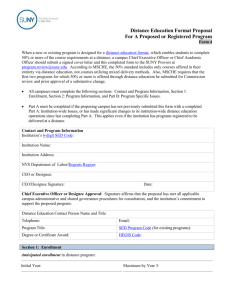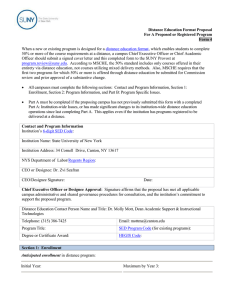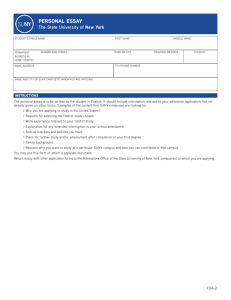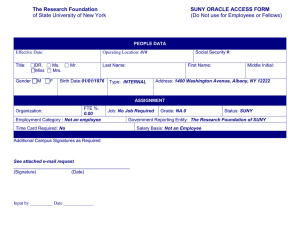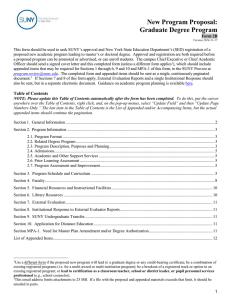Form 4 Distance Education Form
advertisement
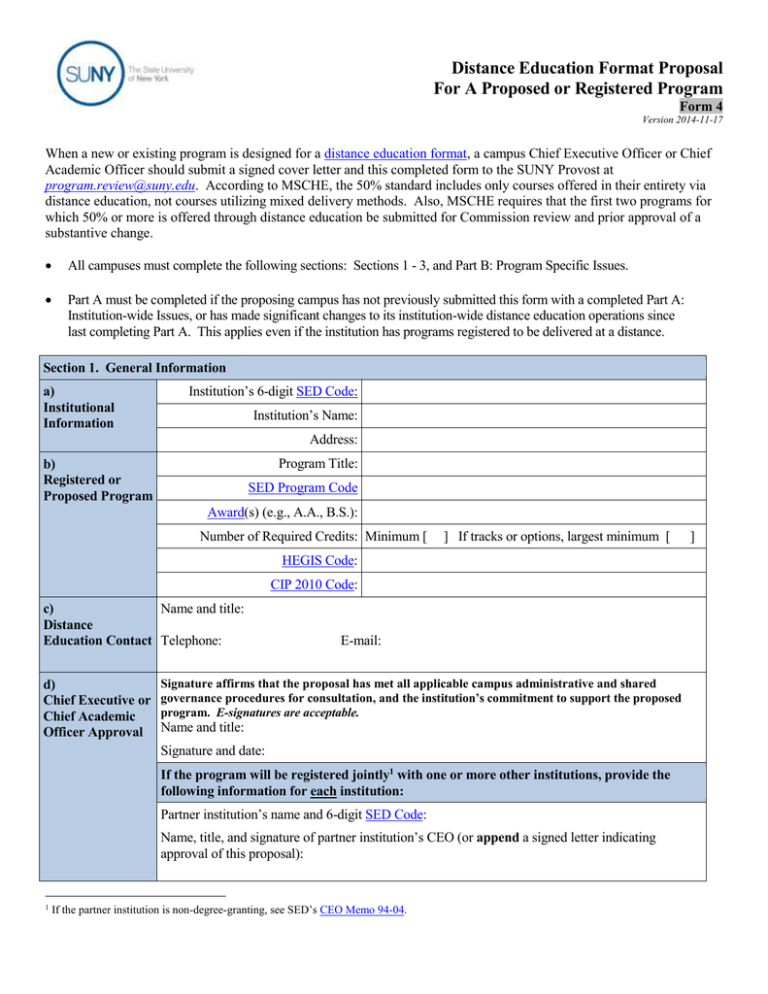
Distance Education Format Proposal For A Proposed or Registered Program Form 4 Version 2014-11-17 When a new or existing program is designed for a distance education format, a campus Chief Executive Officer or Chief Academic Officer should submit a signed cover letter and this completed form to the SUNY Provost at program.review@suny.edu. According to MSCHE, the 50% standard includes only courses offered in their entirety via distance education, not courses utilizing mixed delivery methods. Also, MSCHE requires that the first two programs for which 50% or more is offered through distance education be submitted for Commission review and prior approval of a substantive change. All campuses must complete the following sections: Sections 1 - 3, and Part B: Program Specific Issues. Part A must be completed if the proposing campus has not previously submitted this form with a completed Part A: Institution-wide Issues, or has made significant changes to its institution-wide distance education operations since last completing Part A. This applies even if the institution has programs registered to be delivered at a distance. Section 1. General Information a) Institutional Information Institution’s 6-digit SED Code: Institution’s Name: Address: Program Title: b) Registered or Proposed Program SED Program Code Award(s) (e.g., A.A., B.S.): Number of Required Credits: Minimum [ ] If tracks or options, largest minimum [ HEGIS Code: CIP 2010 Code: Name and title: c) Distance Education Contact Telephone: d) Chief Executive or Chief Academic Officer Approval E-mail: Signature affirms that the proposal has met all applicable campus administrative and shared governance procedures for consultation, and the institution’s commitment to support the proposed program. E-signatures are acceptable. Name and title: Signature and date: If the program will be registered jointly1 with one or more other institutions, provide the following information for each institution: Partner institution’s name and 6-digit SED Code: Name, title, and signature of partner institution’s CEO (or append a signed letter indicating approval of this proposal): 1 If the partner institution is non-degree-granting, see SED’s CEO Memo 94-04. ] Section 2: Enrollment Year 1 2 3 4 5 Anticipated Headcount Enrollment Full-time Part-time Total Estimated FTE Section 3: Program Information a) Term length (in weeks) for the distance program: b) Is this the same as term length for classroom program? [ ] No [ ] Yes c) How much "instructional time" is required per week per credit for a distance course in this program? (Do not include time spent on activities that would be done outside "class time," such as research, writing assignments, or chat rooms.) NOTE: See SUNY policy on credit/contact hours and SED guidance. d) What proportion or percentage of the program will be offered in Distance Education format? Will students be able to complete 100 percent of the program online? If not, what proportion will be able to be completed online? e) What is the maximum number of students who would be enrolled in an online course section? Part A: Institution-wide Issues: Submit Part A only for the first Distance Education program proposed by your institution using this form. SUNY and the State Education Department will keep this in a master file so that your institution will not need to resubmit it for each new proposed online program, unless there are significant changes, such as a new platform. Part A.1. Organizational Commitment a) Describe your institution’s planning process for Distance Education, including how the need for distance access was identified, the nature and size of the intended audiences, and the provisions for serving those audiences, including how each student’s identity will be verified. b) Describe your institution’s resources for distance learning programs and its student and technical support services to ensure their effectiveness. What course management system does your institution use? c) Describe how the institution trains faculty and supports them in developing and teaching online courses, including the pedagogical and communication strategies to function effectively. Describe the qualifications of those who train and/or assist faculty, or are otherwise responsible for online education. d) If your institution uses courses or academic support services from another provider, describe the process used (with faculty participation) to evaluate their quality, academic rigor, and suitability for the award of college credit and a degree or certificate. e) Does your institution have a clear policy on ownership of course materials developed for its distance education courses? How is this policy shared with faculty and staff? NOTE: You may refer to SUNY’s statement on 2 of 4 copyright and faculty ownership of instructional content, and/or faculty contract provisions. Part A.2. Learner Support a) Describe how your institution provides distance students with clear information on: Program completion requirements The nature of the learning experience Any specific student background, knowledge, or technical skills needed Expectations of student participation and learning The nature of interactions among faculty and students in the courses. Any technical equipment or software required or recommended. b) Describe how your institution provides distance learners with adequate academic and administrative support, including academic advisement, technical support, library and information services, and other student support services normally available on campus. Do program materials clearly define how students can access these support services? c) Describe how administrative processes such as admissions and registration are made available to distance students, and how program materials inform students how to access these services. d) What orientation opportunities and resources are available for students of distance learning? Part B: Program-Specific Issues: Submit Part B for each new request to add Distance Education Format to a proposed or registered program. Part B.1. Learning Design a) How does your institution ensure that the same academic standards and requirements are applied to the program on campus and through distance learning? If the curriculum in the Distance Education program differs from that of the on-ground program, please identify the differences. b) Are the courses that make up the distance learning program offered in a sequence or configuration that allows timely completion of requirements? c) How do faculty and others ensure that the technological tools used in the program are appropriate for the content and intended learning outcomes? d) How does the program provide for appropriate and flexible interaction between faculty and students, and among students? e) How do faculty teaching online courses verify that the student who registers in a distance education course or program is the same student who participates in and completes the course or program and receives the academic credit? Part B.2. Outcomes and Assessment a) Distance learning programs are expected to produce the same learning outcomes as comparable classroom-based programs. How are these learning outcomes identified – in terms of knowledge, skills, or credentials – in course and program materials? 3 of 4 b) Describe how the means chosen for assessing student learning in this program are appropriate to the content, learning design, technologies, and characteristics of the learners. Part B.3. Program Evaluation a) What process is in place to monitor and evaluate the effectiveness of this particular distance education program on a regular basis? b) How will the evaluation results will be used for continuous program improvement? c) How will the evaluation process assure that the program results in learning outcomes appropriate to the rigor and breadth of the college degree or certificate awarded? Part B.4. Students Residing Outside New York State SUNY programs must comply with all “authorization to operate" regulations that are in place in other U.S. states where the institution has enrolled students or is otherwise active, based on each state’s definitions. a) What processes are in place to monitor the U.S. state of residency of students enrolled in any distance education course in this program while residing in their home state? b) Federal regulations require institutions delivering courses by distance education to provide students or prospective students with contact information for filing complaints with the state approval or licensing entity in the student’s state of residency and any other relevant state official or agency that would appropriately handle a student's complaint. What is the URL on your institution’s website where contact information for filing complaints for students in this program is posted? NOTE: Links to information for other states can be found at here. 4 of 4
